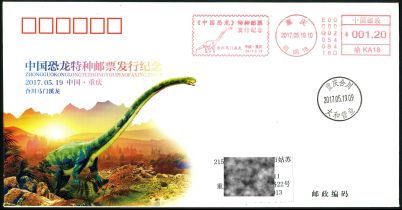the place where Paleontology and Paleoanthropology meets Philately
China
Dinosaurs and other prehistoric animals, fossils, prehistoric human,
Natural History Museums, paleontologists on stamps, postmarks, postal stationeries of China
| << previous country | back to index | next country >> |
Contents:
- Country overview
- Philately in China
- Official stamps of China related to Paleontology
- Personalized stamps of China related to Paleontology
- Other stamps of China to consider
- Post stationery of China related to Paleontology and Paleoanthropology
- Commemorative covers of China related to Paleontology and Paleoanthropology
- Commemorative postmarks and meter frankings of China related to Paleontology
- Some other postmarks of China to consider
- References
- Acknowledgements
China, officially the People's Republic of China (PRC), is a sovereign state in East Asia. It is the world's most populous country, with a population over 1.38 billion people.
China is a one-party state governed by the Communist Party, with its seat of government in the capital city of Beijing. It exercises jurisdiction over 22 provinces; five autonomous regions; four direct-controlled municipalities (Beijing, Tianjin, Shanghai and Chongqing); two mostly self-governing special administrative regions (Hong Kong and Macau); and claims sovereignty over Taiwan.
China's landscape is vast and diverse, ranging from forest steppes and the Gobi and Taklamakan deserts in the arid north to subtropical forests in the wetter south. The Himalaya, Karakoram, Pamir and Tian Shan mountain ranges separate China from South and Central Asia. The Yangtze and Yellow Rivers, the third- and sixth-longest in the world, run from the Tibetan Plateau to the densely populated eastern seaboard. China is a cradle of civilization, with its known history beginning with an ancient civilization – one of the world's earliest – that flourished in the fertile basin of the Yellow River in the North China Plain.
Many unique fossils have been found in China over the last decades. [R1]
The postal system of the People's Republic of China was established as the General Postal Administration in Beijing in 1949, growing out of the posts that had been operating for several years in the liberated areas.
By 1952 the principal postal networks centered on the capital, Beijing, and links to all large cities had been established. Great progress was made in improving the postal service under the First Five-Year Plan. Postal service was also developed in the rural areas. Besides extending rural postal routes, the problem of delivering mail to places below the county level was solved by enlisting the aid of the population. Development was slow; by 1949 there was only 1 post office for every 370 square kilometers.
For many years, China was not a member of the Universal Postal Union, and while using Arabic numerals for the denominations, did not include the country's name in Latin letters as required of UPU nations. The addition of "CHINA" to stamps' inscriptions began in 1992.
The first postage stamps on October 8, 1949, consisting of a set of four depicting a lantern and the Gate of Heavenly Peace, commemorating the 1st session of the Chinese People's Consultative Political Conference.
This issue also inaugurated the innovative practice of numbering each type of stamp issued, usually in the lower left corner.


|

|
| Regular letter with internal tracking number. | Registered letter with two rows of tracking numbers. |
Since 2019 Chinese Post added a sticker with internal tracking number on regular letters, in order to improve their service.
Distinguished from the label on registered letters, the label of regular letter is a bit longer and has only one row for the tracking number.
Official stamps of China related to Paleontology: fossils, dinosaurs and other prehistoric animals, prehistoric humans
| 15.04.1958 "Chinese Paleontology" [1] | 20.08.1991 "13 th Conference of International Union for Quaternary Research" [4] | 01.11.1999 "Scientific and Technological Achievements" [3] |
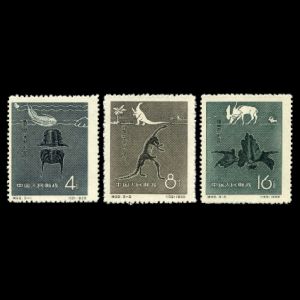 |
 |
 |
| 19.05.2017 "Chinese Dinosaurs" [3] | 18.04.2024 "Chengjiang Fossil Site" | |

|
 |
|
Notes:
[1] The stamp of Dinosaur is the first dinosaur stamp ever.
The stamps set "Chinese Paleontology" issued in the year of 100th anniversary of co-publication of Alfred Russel Wallace and Charles Darwin paper "On the Tendency of Species to form Varieties; and on the Perpetuation of Varieties and Species by Natural Means of Selection" on a meeting at the Linnaean Society on 1 July 1858 in London, UK.
In the following year, on 24 November 1859, Charles Darwin published his most famous book "Origin of Species" (or more completely, On the Origin of Species by Means of Natural Selection, or the Preservation of Favoured in the Struggle or Life).
 [2] A fossil of Anomalocaris is depicted on one of the stamps
in this set.
Anomalocaris is thought to have been a predator.
It propelled itself through the water by undulating the flexible lobes on the sides of its body.
Each lobe sloped below the one more posterior to it, and this overlapping allowed the lobes on each
side of the body to act as a single "fin", maximizing the swimming efficiency.
The construction of a remote-controlled model showed this mode of swimming to be intrinsically stable,
implying that Anomalocaris would not have needed a complex brain to manage balance while swimming.
The body was widest between the third and fifth lobe and narrowed
towards the tail; it had at least 11 lobes in total.
It is difficult to distinguish lobes near the tail, making an accurate count difficult.
[R4]
[2] A fossil of Anomalocaris is depicted on one of the stamps
in this set.
Anomalocaris is thought to have been a predator.
It propelled itself through the water by undulating the flexible lobes on the sides of its body.
Each lobe sloped below the one more posterior to it, and this overlapping allowed the lobes on each
side of the body to act as a single "fin", maximizing the swimming efficiency.
The construction of a remote-controlled model showed this mode of swimming to be intrinsically stable,
implying that Anomalocaris would not have needed a complex brain to manage balance while swimming.
The body was widest between the third and fifth lobe and narrowed
towards the tail; it had at least 11 lobes in total.
It is difficult to distinguish lobes near the tail, making an accurate count difficult.
[R4]

|

|
[3] First dinosaur stamps of China since 1958. All stamps show dinosaurs and other prehistoric animals whose fossils are found in China. These stamps are special:
- The mini-sheets show a wide number of sheet numbers with a dinosaur silhouette printed next to them. Several silhouettes were used.
- Skeletons of the dinosaurs can be seen under UV light.
- Many commemorative postmarks and meter franking issued in different cities around the country.
- Perforation on top-side of Mini-Sheets and the Block are in shape of dinosaurs.
[4] "13 th Conference of International Union for Quaternary Research" stamp available with two perforations:
11.00x11.50 MiNr: 2380A, Scott: 2346
11.50x11.50 MiNr: 2380C, Scott: 2346a,
Some personalized stamps of China related to Paleontology: dinosaurs
| xx.xx.xx | 2011 "Fossils" | xx.xx.2013 "China Dinosaur Land park in Changzhou" |
 |
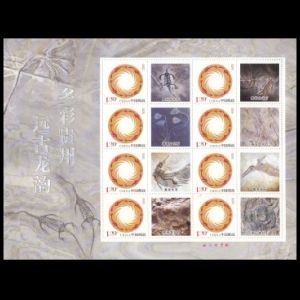 |
 |
| 19.05.2017 "Dinosaurs" [P1] | ||
 |
 |
|
Notes:
[P1] issued together with official "Chinese Dinosaur" stamps and sold with some souvenir stuff.
Other stamps of China to consider: Natural History Museums, contributors to Paleontology science.
| 03.06.1932 "Sino-Swedish Expedition (1927-1933)" [O4] | 01.04.1959 "Museum of Natural History" | 01.12.1962 "Scientists of Ancient China" [O1] |
 |
 |
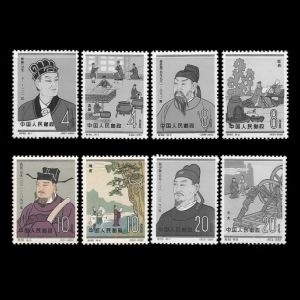 |
| 09.11.2002 "Museums of China" [O2] | 01.05.2004 "Danxia Mountain" [O3] | 24.11.2021 "Ancient DNA Indicates China’s Prehistoric Human Population Shifts and Admixture" [O4] |
 |
 |
 |
Notes:
[O1] Two stamps with face value of 10f are dedicated to Shen Kua (1031-1095). Shen Kuo devised a geological hypothesis for land formation (geomorphology), based upon findings of inland marine fossils, knowledge of soil erosion, and the deposition of silt. He also proposed a hypothesis of gradual climate change, after observing ancient petrified bamboo that were preserved underground in a dry northern habitat that would not support bamboo growth during his time. [R6]
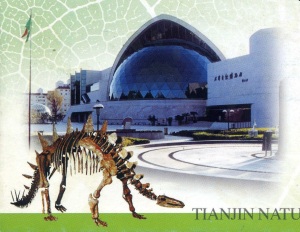
[O2] One of the stamps shows building of the Tianjin Natural History Museum.
The museum located at the west end of Machang Road, was set up in 1914 by a French missionary and opened in 1927, with the previous name as Beijiang Museum. It acquired the present name in 1957.
The museum specializes in paleontological and paleoanthropological fossils. The collections include over 380,000 specimens and key collections cover the paleontology of the late period of the Chinese Cenozoic. These Cenozoic fossils include ancient mammals excavated from the Yushe Basin of Shanxi Province, the Qingyang Basin of the Gansu Province, the Yang Yuanni Basin of the Hebei Province, and from Inner Mongolia. As specimens of these animals are rare outside of China, the collections of the Tianjin Natural History Museum are an important collection for the study of these organisms. The museum has 4 major exhibits – with displays on Animals, Paleontology, Plants and Paleoanthropology. Other fossils on display include ancient reptiles and mammals, insects and aquatic organisms. [R9]
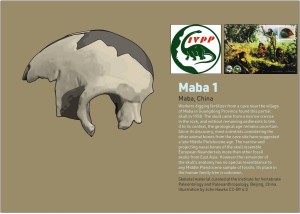
|
|
The skull of Maba Man as illustrated by Dr. John Hawk.
Dr. Hawk is an associate professor of anthropology at the University of Wisconsin-Madison. The slide is part of a series of slides “Evolution of mankind and philately” prepared by Philatelist Peter Brandhuber. |
[O3] Danxia Mountain was inscribed as part of the China Danxia World Heritage Site in 2010 because of its unique geographical in formations and spectacular scenery.
The Danxia area is formed from a reddish sandstone which has been eroded over time into a series of outcrops surrounded by spectacular cliffs and many unusual rock formations known as Danxia landform.
Danxia Mountainhas a long development history with plentiful scenes and sights of cultural interest.
Our ancestors used to live near Danxia Mountain long time ago. Skull fossils of famous Maba Man found in the southwest of Danxia basin.
The skull pieces were found in June 1958 in a cave in Lion Rock, near the town of Maba, in Guangdong province, China. Its age estimated between 200.000 and 300.000 years old and was labeled an intermediate in form between Homo erectus and Homo sapiens. [R5]
[O4] In 1932, China released a set of four stamps in honor of "the Sino-Swedish Expedition" The design features a painting called Nomads in the Desert, which (at least at the time) was part of the collections of the Palace Museum in Peking (now Beijing).
From 1927 to 1933 Sven Hedin was the lead of the Northwest Scientific Expedition, also known as "the Sino-Swedish Expedition". It included some 50 Swedish, German, and Chinese scientists and researchers. The expedition was financed not only by Sweden but also from international sources. They made numerous important scientific discoveries, including geological and paleontological discoveries in Inner Mongolia and Sinkiang. These discoveries included also remains of some dinosaurs, though many were only fragmentary remains.
According to the agreement with the Chinese authorities some fossils were repatriated in the early 1950s, and allegedly also during the period of the Cultural Revolution, and today at least the early consignments are found in the Museum of Paleontology in Beijing. Parts of the collections are, however, still found in Sweden, where these collections were allowed to remain; today with the Museum of Natural History, Stockholm. [R10]
[O5] The stamp of 120 Fen has the title "Ancient DNA Indicates China’s Prehistoric Human Population Shifts and Admixture" (Genetic Research into Ancestry).
Post stationery of China related to Paleontology: fossils, dinosaurs and other prehistoric animals, prehistoric humans.
| 19.10.1989 "60th Anniversary of the Discovery of the first skull of Peking Man" [PS1] | 2002 "Dinosaur of Zhu Cheng - World's Largest Duck-billed Dinosaur Fossil" [PS2] | 27.06.2004 "The first International Conference on Geoparks" [PS3] | |
 |
 |
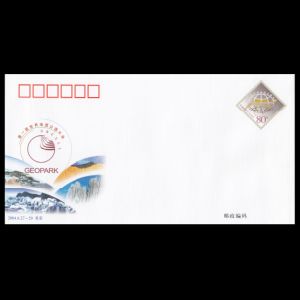 |
|
| 2007 "China Dinosaur Land park at Changzhou" [PS4] | 2008 "Sinosauropteryx" [PS5] | ||
 |
 |
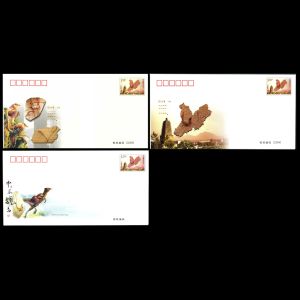 |
|
| 2011 "Zigong Dinosaur Museum" | 2018 "The Centenary of the discovery of Zhoukoudian site" | 2020 "Dinosaur of Zhu Cheng - World's Largest Duck-billed Dinosaur Fossil" [PS2] | |
 |
 |
 |
|
Notes:
[PS1] Commemorative pre-stamped envelope "60th Anniversary of the Discovery of the first skull of Peking Man" with imprinted stamp of Peking Man.
The following text is written on its reverse side:
The first skull of Peking Man (Homo erectus pikenesis) was discovered by Pei Wenzhong (1904-1982), a Chinese scientist on December 2 1929 at Zhoukoudian, Fangshan Country, 48 kilometer southwest of Beijing.
Peking Man is an important link in the evolution of mankind.
And "from ape to man" is a major chapter in the study of the materialistic conception of history of Marxism.
The discovery of the first skull of Peking Man is a great contribution to the research of the evolution of mankind.
On October 19, 1989, the Ministry of Post and Telecommunications issued this commemorative pre-stamped envelope. The stamp on the envelope features a bust of female of Peking Man and the cachet shows a living scene of Peking Man.
[PS2] The postal stationery "Shantungosaurus dinosaur of Zhu Cheng - World's Largest Duck-billed Dinosaur Fossil".
The imprinted stamp shows the dinosaur's skeleton mounted in the museum of Zhucheng Cretaceous Dinosaur Geo-park. [R3]
There are many covers with this imprinted stamp. The cachet on the most of these covers shows some buildings and landscapes, but one postal stationery shows a skeleton of the dinosaur on the cachet.
Similar postal stationary was issued at the end of 2020, with a reconstruction of the dinosaur instead of its fossils depicted on the cachet. The imprinted stamp has the same design but different face value. The stamp from 2002 has a value of 0.80 when the stamp 2020 has a value of 1.20. According to the text on the reverse side of the cover, the new face value was introduced in 2009.
The reverse side of the cover from 2002 has the following text:
 Zhu Cheng is the famous "Village of The Dinosaurs".
Zhu Cheng is the famous "Village of The Dinosaurs".
The world's biggest duck-billed dinosaur fossil was discovered here.
It has the height of 9.1m and 16.6m in length.
It lived approximately 70 MY ago and it was amphibious.
It has such a name because of its flat and wide bill, similar to a duck.
Since its discovery in 1964, Zhu Cheng already has 4 of the dino fossils
displayed in Beijing, Tian Jing, Ji Nan and Zhu Cheng.

|
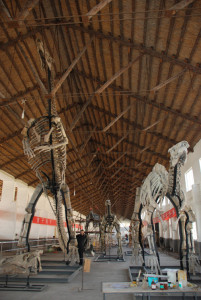
|
| The image is from Wikipedia. | The image is from archosaurmusings.wordpress.com. |
Shantungosaurus, meaning "Shandong Lizard",
is a genus of saurolophine hadrosaurid dinosaurs who lived during the Late Cretaceous Period
(100-65 million years ago) on the territory of modern China.
There is only one species of the dinosaur - Shantungosaurus giganteus, the largest Hadrosaur known to date.
First described in 1973, Shantungosaurus is known from over five incomplete skeletons.
Chinese scientist Xing Xu and his colleagues indicate that Shantungosaurus is very similar to and shares many
unique characters with Edmontosaurus, forming an Asian node of Edmontosaurus–Shantungosaurus
clade, based on the new materials recovered in Shandong.
[R7]
[PS3] Commemorative pre-stamped envelope "The first International Conference on Geoparks" with imprinted stamp that shows an ornithopod dinosaur inside, very likely the same Duck-billed Dinosaur from Zhu Cheng formation as imprinted on post stationery from 2002.
The following text is written on its reverse side:

The theme of the Conference was "the Protection and the Sustainable Development of the Geological Heritages". At the conference the delegates from various countries exchanged their experiences in protecting geological heritage and building geoparks so as to push forward the sound development of global geoparks, to promote man-land harmony and to protect our earth better. This conference was an important milestone in the history of developing global geoparks.
In commemoration of the First International Conference on Geoparks, the State Post Bureau issued a commemorative pre-stamped envelope.
|
[PS4] In 2007 State Post Bureau of China issued several postal stationeries
(pre-stamped post cards and pre-stamped commemorative envelope) with title "China Dinosaur Land park in Changzhou". Both, imprinted stamp and illustration (cachet) of the pre-stamped envelope (C5 size) shows an entrance of the park with models of some dinosaurs in the front. Imprinted stamp on postcard attached to entrance ticket of China Dinosaur land theme park at Changzhou shows four very recognizable prehistoric animals, three dinosaurs: (Tyrannosaurus, Triceratops, Brachiosaurus) and pterosaur Pteranodon. The same design was used for one of postmarks issued in 2017 on the same date as the Chinese Dinosaur stamps above. At least five varieties of this postcard were issued with the same stamp. Note: the are a lot of pre-stamped post cards issued in China in latest years that shows fossils or reconstructions of prehistoric animals on a face side, with "standard" imprinted stamps at domestic rate on the reverse, as shown on the right. Set of 8 pre-stamped post cards "The Cretaceous Park in China" from 2003, that shows various fossils discovered at Liaoning province of China. Even though such post cards might be considered by some collectors they are excluded from this catalog. |
 |

|

|
||
[PS5] Many pre-stamped commemorative envelops with imprinted stamps of Sinosauropteryx were issued by State Post Bureau of China in 2008. Illustrations (cachets) of most of them are not related to Paleontology at all. Only three covers with fossils or reconstruction of Sinosauropteryx on its illustrations are known. The following text is written on (on Chinese) the reverse side of these pre-stamped covers:
 Sinosauropteryx lived approximately 125 million years ago during the Early Cretaceous period.
The fossil was found and described in 1996 at Zhao Yang, China.
It was the first dinosaur to be found with evidence of feathers.
Sinosauropteryx lived approximately 125 million years ago during the Early Cretaceous period.
The fossil was found and described in 1996 at Zhao Yang, China.
It was the first dinosaur to be found with evidence of feathers. Sinosauropteryx is currently classified as a member of the family Compsoghathidae in the Theropod dinosaurs.
They are categorized as Compsognathidae in the Theropod suborder.
The Sinosauropteryx was the size of a chicken.
Its head was large, the upper and lower jaws were full of razor sharp teeth, similar to a saw. The front limbs were short, the tail was surprisingly long. It’s skin was covered in filamentous feathers from head to toe, it was considered the most primitive form of feathers. Its discovery strongly supported the hypothesis that birds originated from Theropod dinosaurs
Commemorative covers related to Paleontology: fossils, dinosaurs and other prehistoric animals
| 10.09.2001 "The Paleontological Fossils in the West of Liaoning province of China" [Cov1] | 09.11.2002 "Tianjin Natural History Museum" [O2] [Cov2] | 19.05.2017 "Chinese Dinosaurs [3] [FDC] [Cov3] |
 |
 |
 |
| 2017 "Chinese Dinosaurs" [3] [FDC] | 2019 "Paleontologic Museum of China in Beijing" | 2020 "Zhoukoudian site" |
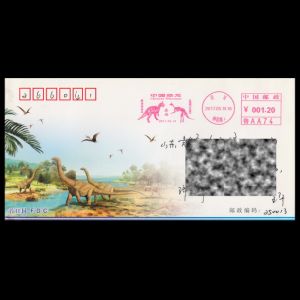 |
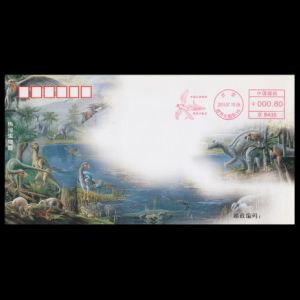 |
 |
Notes:
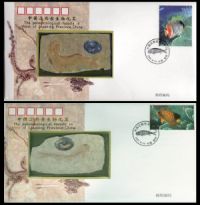 [Cov1] Often offered on the Internet as "FDC" with stamp of modern fish and
postmark 'Fossil of Liaoning, China" that shows some fish, perhaps a prehistoric one.
[Cov1] Often offered on the Internet as "FDC" with stamp of modern fish and
postmark 'Fossil of Liaoning, China" that shows some fish, perhaps a prehistoric one. This cover also includes a slab of rock with a unique embedded fossil fish.
An origin certificate is included inside the cover – which shows through the green window on the left side of the cover.
The following text is written on its reverse side:
In order to protect and use the precious legacy of China and the world, the inlaid cover was made of paleontological fish fossils 135 million years ago (from late Jurassic Period to early Cretaceous Period) in Liaoxi, China.
[Cov2] Often offered in Internet as "FDC" with stamp of the Tianjin Natural History Museum.
The following text is written on its reverse side:
Tianjin Natural history Museum began in 1914 with its original name "Museum Hoang-Ho Pai-Ho".
She enjoys great prestige both at home and abroad or its age-old history, rich collection and distinguished excellence in
scientific researches and discoveries.
Specimens kept by the museum that include living being and geology fossils, forms 3 major characteristics.
They are characterized by its rich sources in culture, collection are rich and distinguished scientific research discoveries.
All the specimens have been gathered together within this museum for use in research, exhibition and international exchange.
In the interest of this legacy, the Municipal People's Government rebuilds this museum in 1997.
The new museum occupies a total of 20.000m2 with the main building taking up 12.000m2.
On the 28th of October 1998, it will be opened public viewing.
In the feature, we will strive to excel in the interest of scientific purposes, educate the young in natural science and cultivate a sense of
environment consciousness among the people.
[Cov3] Often offered as "FDC" with commemorative postmark or meter franking issued on the same day with "Chinese Dinosaurs" stamps on 19.05.2017. The following text is written on the reverse side of these pre-stamped covers:
Commemorative postmarks and meter franking of China related to Paleontology and Paleoanthropology: fossils, dinosaurs and other prehistoric animals, prehistoric humans.
 In addition to many commemorative postmarks, there are also many decorative marks in China.
In addition to many commemorative postmarks, there are also many decorative marks in China.For example the red marks on the postcards shown on the right side. By closer look it can be seen that there are no date on these marks, but some Chinese text only.
Legend is here
| 1 | 2 | 3 | |
| 15.04.1958 "Chinese Paleontology" [FDC] [1] | 01.04.1959 "Museum of Natural History" [FDC] | 19.10.1989 "60th Anniversary of the Discovery of the first skull of Peking Man" - | |
| 1 |  |
 |
 |
| 19.10.1989 "60th Anniversary of the Discovery of the first skull of Peking Man" | 02.12.1989 "60th Anniversary of the Discovery of the first skull of Peking Man" - | ||
| 2 |  |
 |
 |
| 02.08.1991 "XIII International Quaternary Conference" - | 15.02.1991 " " | ||
| 3 |

|
 |
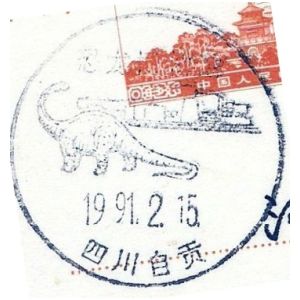 |
| 16.05.1992 "Lantian Man Homo erectus lantianensis" - | 01.10.1992 "Lantian Man Homo erectus lantianensis" - | 02.12.1995 "Homo erectus pekinensis" - | |
| 4 | 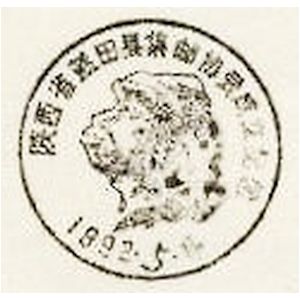 |
 |
 |
| 04.08.1996 " " - | 20.12.1996 "Nanjing - Tang-Shan Cave and ape man" - | 24.09.1998 "Homo erectus" - | |
| 5 | 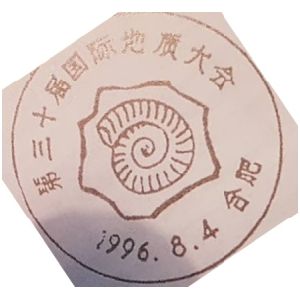 |
 |
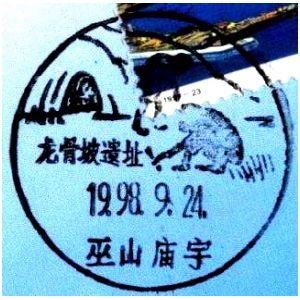 |
| 26-27.09.1998 "Minerals ad Fossils Exhibition LUCCA'98" | |||

|
|
||
| 30.04 - 03.05.1999 "Peking Man" - | 04.05.2000 "Ultrasaurus tabriensis" - | 25.12.2000 "Peking Man" - | |
| 6 |  |
 |
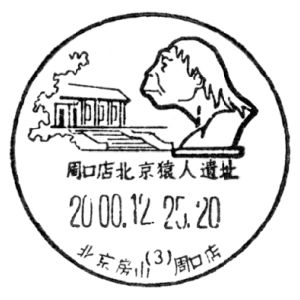 |
| 01.05.2000 "Yuanmou - Homo erectus yuanmouensis" | 10.01.2001 "Lu Feng Dinosaur" PM | 24.01.2001 "Year of snake: fossil of giant snake from Linqu city" - |
|
| 7 | 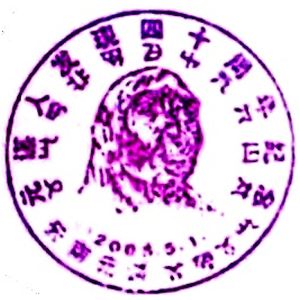 |
 |
 |
| 07.03.2001 "Fossil of rhinoceros" | 09.04.2001 " | xx.10.2001 " | |
| 8 |  |
 |
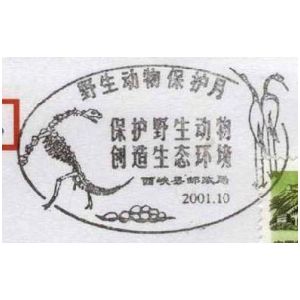 |
| 06.03.2002 "Xixia Dinosaur Relics Park - Discovery of dinosaur's eggs" | xx.03.2002 "Xixia Dinosaur Relics Park" - |
01.04.2003 "Microraptor and Peking man" - | |
| 9 |
 |
 |
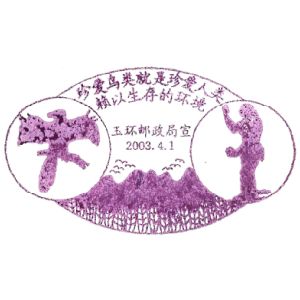 |
| 21.04.2003 "Microraptor" - | 20.12.2003 "Nanjing - Tang-Shan Cave" - | 09.02.2005 "Yuanmou - Homo erectus yuanmouensis" | |
| 9a | 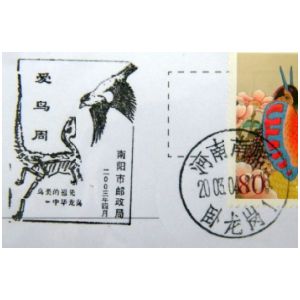 |
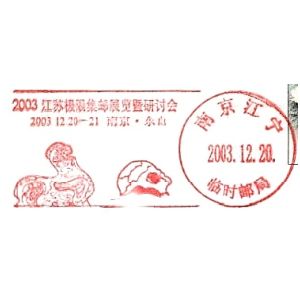 |
 |
| 18.04.2005 "Gansu bird bone fossil from the early cretaceous period" | 22.04.2005 " | 18.05.2005 "Xixa world museum (dinosaur eggs)" | |
| 10 |
 |
 |
 |
| 04.10.2005 " | 04.10.2005 "World animal day: Gansu fossil" | 13.10.2005 "Funiushan geopark - dinosaur's nest" | |
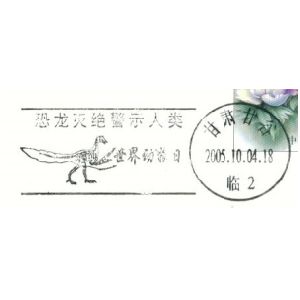 |
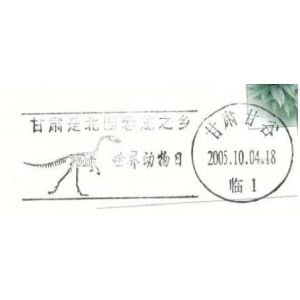 |
 |
|
| 11.11.2005 "180 years since discovery of first Iguanodon's teeth (Mary Ann and her husband Gideon Mantell" | 11.11.2005 "180 anniversary since first dinosaur described by scientists - Othniel Charles Marsh (famous paleontologist and fossil hunter)" | 11.11.2005 "180 anniversary since first dinosaur described by scientists - Edward Drinker Cope (famous paleontologist and fossil hunter)" | |
| 12 |  |
 |
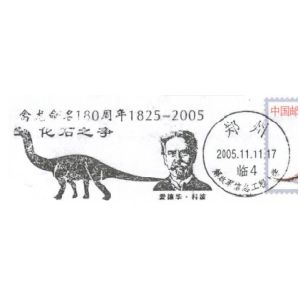 |
| 11.11.2005 " "- | 12.11.2005 " " | 21.11.2005 " " - | |
| 13 | 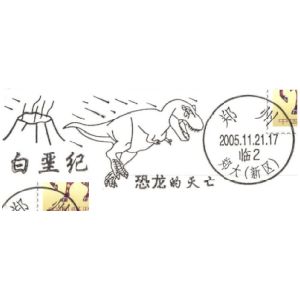
|
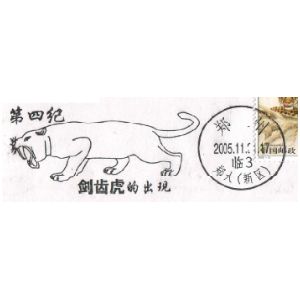 |
 |
| 21.11.2005 " " - | 01.12.2005 "" | 04.12.2005 "" | |
| 14 |  |

|
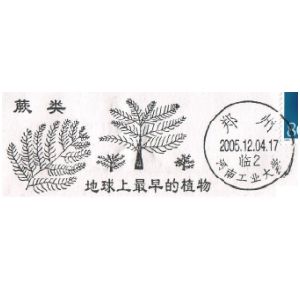 |
| 10.12.2005 " | 17.12.2005 " | 12.03.2006 "Fossil and Paleontologist" - | |
| 15 |  |
 |
 |
| 12.03.2006 "Ginkgo Biloba Leaf and Dinosaur (?)" | |||
| 16 |  |
 |
 |
| 22.04.2006 "Yongji Liujiaxia dinosaur park" | 22.04.2006 "Dinosaur's eggs and embryo from Nanyang province" | 22.04.2006 "Dinosaur's fossil from Gongbouqian province" - | |
| 17 |
 |
 |
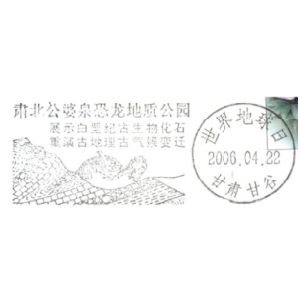 |
| 22.04.2006 "37th World Earth Day, Placoolithus taohoensis dinosaur egg fossil" | 20.08.2006 "Funiushan World Geopark" | 21.08.2006 "Funiushan World Geopark" | |
| 18 |
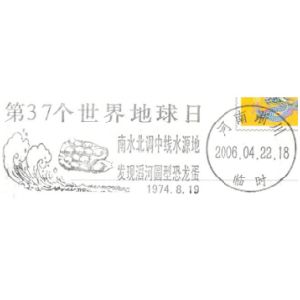 |
 |
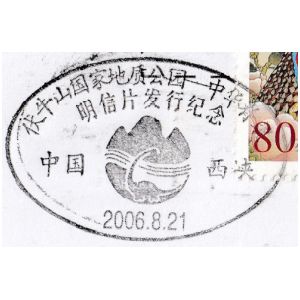 |
| 19.01.2007 "China Dinosaur Land park in Changzhou" - | 14.02.2007 "Changchun dinosaur" | 18.06.2007 "China Dinosaur Land park in Changzhou" | |
| 19 |
 |
 |
 |
| 01.07.2007 " " | 02.07.2007 "Gansu dinosaur" | 21.09.2007 "Nanjing - Tang-Shan Cave" - | |
| 20 |
 |
 |
 |
| 15.12.2007 " " - | 24.07.2008 "China Lianwu dinosaur" | 20.11.2008 " - | |
| 20a |
 |
 |
 |
| 18.05.2009 "Nanyang world museum day" | 22.04.2010 "New discovered fossil of Mononykus dinosaur" | 11.11.2011 " | |
| 21 |  |
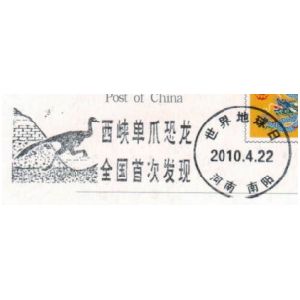 |
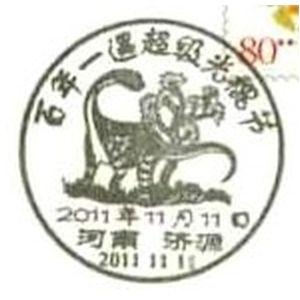 |
| 21.03.2012 " | 22.04.2013 " | 22.04.2013 "44th world earth day" | |
| 22 | 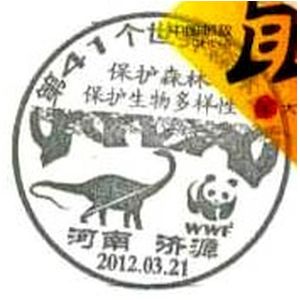 |
 |
 |
| 13.10.2013 "Dinosaur's eggs" | 23.09.2014 "Dinosaur from Zigong province" | 22.04.2016 "Henan Long fossil (Sinokannemeyeria?)" | |
| 23 |  |
 |
 |
The following postmarks and meter franking are issued on the day of "Chinese Dinosaurs" stamps release: May 19th, 2017 |
|||
| 19.05.2017 "Yangchuanosaurus" [FDC] | 19.05.2017 Mamenchisaurus, Beijing" [FDC] | 19.05.2017 "Dinosaur in egg - Xixia Dino Relics Park, Nanyang City of Henan Province" [FDC] - | |
| 24 |  |
 |
 |
| 19.05.2017 "Tsintaosaurus and Gigantoraptor, Liaocheng city of Shandong province" [FDC] | 19.05.2017 "Tsintaosaurus, Shenyang City of Liaoning" [FDC] | 19.05.2017 "Tsintaosaurus, Laiyang of Shandong" [FDC] | |
| 25 |  |
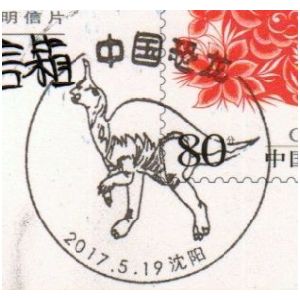 |
 |
| 19.05.2017 "Mamenchisaurus, Yangchuanosaurus & Pteranodon, Shaoxing of Zhejiang" [FDC] | 19.05.2017 "Mamenchisaurus, Yangzhou City of Jiangsu" [FDC] | 19.05.2017 "Mamenchisaurus, Shanghai [FDC] | |
| 26 |  |
 |
 |
| 19.05.2017 "Mamenchisaurus & Pterosauria, Nanjing of Jiangsu" [FDC] | 19.05.2017 "Xinjiangtitan shanshanensis, Piqan County of Xinjiang" [FDC] | 19.05.2017 "Mamenchisaurus Mt Emei city of Anhui province" [FDC] | |
| 27 | 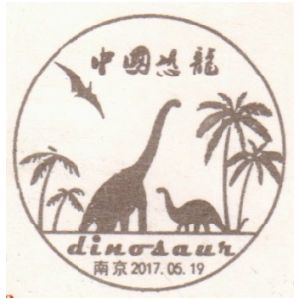 |
 |
 |
| 19.05.2017 "Mamenchisaurus, Changzhou city of Jiangsu province" [FDC] | 19.05.2017 "M,amenchisaurus Chuzhou City of Anhui" [FDC] | 19.05.2017 "Xinjiangtitan shanshanensis, Yueqing City of Zhejiang" [FDC] | |
| 28 |  |
 |
 |
| 19.05.2017 "Fossil of Yangchuanosaurus, Changzhou city of Jiangsu province" [FDC] | 19.05.2017 "Huayangosaurus, Hangzhou city of Zhejiang province" [FDC] | 19.05.2017 " " [FDC] | |
| 29 |  |
 |
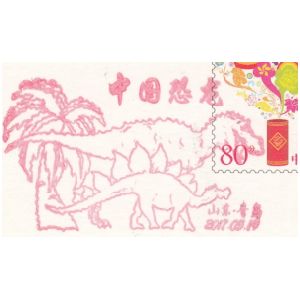 |
| 19.05.2017 "Mamenchisaurus, Beijing" [FDC] | 19.05.2017 "Sinosauropteryx and Shantungosaurus, Beijing geology Museum" [FDC] | 19.05.2017 "Qingdao City of Shandong Province [FDC] | |
| 30 |
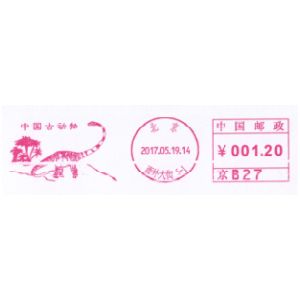 |
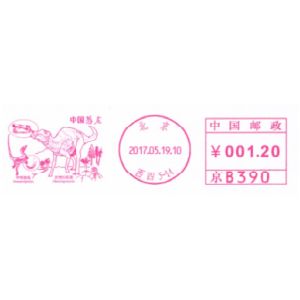 |
 |
| 19.05.2017 "Diplodocus, Yinchuan City of Ningxia Hui Autonomous Region" [FDC] | 19.05.2017 "Tsintaosaurus, Laiyang City of Shandong Province" [FDC] | 19.05.2017 "Liaoning province" [FDC] | |
| 31 |  |
 |
 |
| 19.05.2017 "Tsintaosaurus, Jinan in Shandong province" [FDC] | 19.05.2017 "Yangchuanosaurus, Chongqing city of Sichuan province" [FDC] | 19.05.2017 "Mamenchisaurus, Chongqing city of Sichuan province" [FDC] | |
| 32 |  |
 |
 |
| 19.05.2018 "China Dinosaur Land park at Changzhou" | 19.05.2017 "Pteranodon, Triceratops, Mamenchisaurus, Linhai of Zhejiang" [Sp] | 19.05.2018 " | |
| 33 |  |
 |
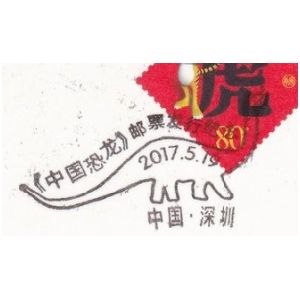 |
| 19.05.2017 "Xinjiangtitan shanshanensis, Nanning City of Guangxi" [FDC] | 19.05.2017 "Mamenchisaurus, Yibin City of Sichuan" [FDC] | 19.05.2017 "Yangchuanosaurus" [FDC] | |
| 34 |  |
 |
 |
| 19.05.2017 "Yangchuanosaurus, Zhaozhuang in Shandong" [FDC] | 19.05.2017 "Yangchuanosaurus, Guangzhou City of Guangdong" [FDC] | 19.05.2017 "Huayangosaurus, Zigong city of Sichuan province" [FDC] | |
| 35 |  |
 |
 |
| 19.05.2017 "Fossil of Theropoda, Nanyang of Henan" [FDC] | 19.05.2017 "Nanyang city of Henan province" [FDC] [C2] * - | 19.05.2017 "Stegosaurus, Wuxi of Jiangsu" [FDC] | |
| 36 |  |
 |
 |
| 19.05.2017 "Gigantoraptor, Beibei of Chongqing" [FDC] | 19.05.2017 "Huayangosaurus on Prepaid Card, Beibei of Chongqing" [FDC] | 19.05.2017 "Mamenchisaurus, Beibei of Chongqing" [FDC] | |
| 37 |  |
 |
 |
| 19.05.2017 "Microraptor, Beibei of Chongqing" [FDC] | 19.05.2017 "Sinosauropteryx, Xinhua of Hunan province" [FDC] | 19.05.2017 "Tsintaosaurus, Beibei of Chongqing" [FDC] | |
| 38 |  |
 |
 |
| 19.05.2017 "Dalian of Liaoning province" [FDC] | 19.05.2017 "Yangchuanosaurus, Beibei of Chongqing" [FDC] | 19.05.2017 "Mamenchisaurus, Xinhua of Hunan" [FDC] | |
| 39 | 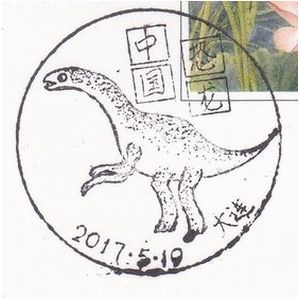 |
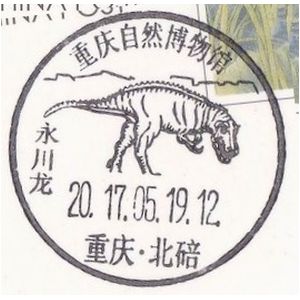 |
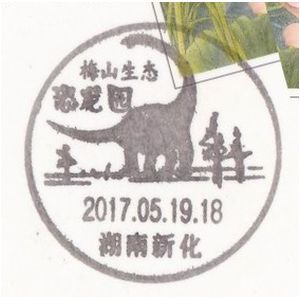 |
| 19.05.2017 "Triceratops, Dragon (?), Xi'an of Shaanxi" [FDC] | 19.05.2017 "Parasaurolophus, Sinoceratops, Zhucheng" [FDC] | 19.05.2017 "Tsintaosaurus, Laiyang of Shandong" [FDC] | |
| 40 |  |
 |
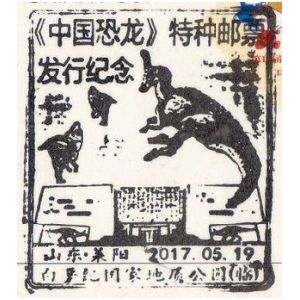 |
| 19.05.2017 "Yancheng of Jiangsu province" [FDC] | 19.05.2017 "Huayangosaurus (?), Xiamen of Fujian province" [FDC] | 19.05.2017 "Handan city of Hebei province" [FDC] | |
| 41 |  |
 |

|
| 19.05.2017 "Yangchuanosaurus" [FDC] | 19.05.2017 "Yangchuanosaurus" [FDC] | 19.05.2017 "Mamenchisaurus" [FDC] | |
| 42 |  |
 |
 |
| 09.06.2018 "The Centenary of the discovery of Zhoukoudian site" | 10.07.2019 "Microraptor on meter franking of Paleozoological Museum of China " | ||
| 43 | 
|
 |
 |
| 19.07.2020 "Lantian Man" | 27.04 - 01.05.2023 "Fossil of Fuxianhuia from the Chengjiang biota, Kunming 2023 All-China Philatelic Exhibition" [Sp] | 18.05.2023 - 17.05.2024 "Kunming fish" fossil (Haikouichthys) [Sp] [PM1] | |
| 44 | 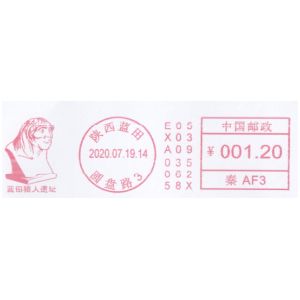 |
 |
 |
| 07.08.2023 "Dinosaurs througn mail" - fun event [Sp] [PM2] | |||
| 45 | 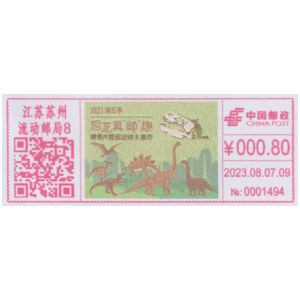 |
|
|
| 18.04.2024 - "Chengjiang Fossil Site" [FDC] | |||
| 46 |  |
 |
 |
| 18.04.2024 - "Chengjiang Fossil Site" [FDC] | |||
| 47 |  |
 |
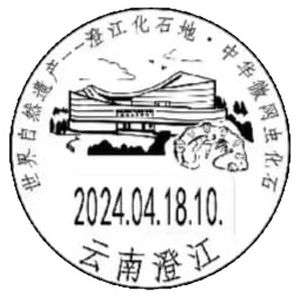 |
| 18.04.2024 - "Chengjiang Fossil Site" [FDC] | |||
| 48 |  |
 |
 |
| 18.04.2024 - "Chengjiang Fossil Site" [FDC] | |||
| 49 |  |
 |
 |
| 18.06.2025 - "Explore the Dinosaur Mystery of Guangxi" [Sp] | |||
| 50 |  |
 |
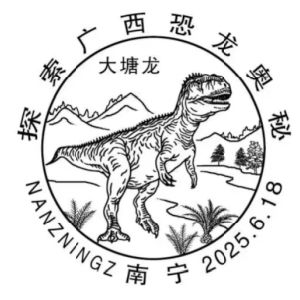 |
Notes:
[PM1] The self-adhesive meterfranking label, with "Kunming fish" fossil (Haikouichthys) on the label in the middle.
Haikouichthys is an extinct genus of craniate (animals with notochords and distinct heads) that lived 518 million years ago. Haikouichthys had a defined skull and other characteristics that have led paleontologists to label it a true craniate, and even to be popularly characterized as one of the earliest fishes. The holotype of Haikouichthys ercaicunensis was found in the Yuansshan member of the Qiongzhusi Formation in the 'Eoredlichia' Zone near Haikou at Ercaicun, Kunming City, Yunnan, China, hence its name "Haikou fish from Ercaicun". The fossil of "Kunming fish" is the earliest vertebrate found so far, which provides an important basis for the evolution from fish to man. [R11]

An example of circulated commemorative cover is here.
[PM2]
|
On August 8th, 2023, the Shanghai Mass Art Museum, after two years of interruption
due to the COVID pandemic, organized the "Dinosaur Resurrection" event.
[R12] The event was integrated with multiple elements such as markets, lectures, handicrafts, and joint writing films, so that the friends who came to participate in the event spent a rich day and attracted many dinosaurs lovers. The special guest of the event was Spanish Post, whe presented their postage stamp and related philatelic products "Aragonese dragon (Aragosaurus ischiaticus)", issued in April this year. Chinese Post introduced the meter franking with five "Chinese Dinosaurs" and the postcrossing postcard: |

|
 |
Other postmarks to consider: fossil-found places, Natural History Museums
Legend is here| 02.08.1991 "Dragonbone hills" - | ||
 |
 |
 |
| 09.03.2003 "Nanjing - Tang-Shan Cave" - | 19.01.2007 "China Dinosaur Land park at Changzhou" - | 15.12.2007 "Nanyang Natural History Museum" - |
 |
 |
 |
References:
- [R1] China: Wikipedia, WikiTravel, FlagCounter.
- [R2] Postal History and Philately of China:
Wikipedia,
Links to official website of the Post Authority, stamp catalog and a list of new stamps of China are here. - [R3] Dinosaur fossil group discovered in Zhucheng, Shandong: globalgeopark.org
- [R4] Anomalocaris: Wikipedia
- [R5] Shen Kua: Wikipedia
- [R6] Tianjin Natural History Museum: Wikipedia official website (on Chinese)
- [R7] Shantungosaurus: Wikipedia
- [R8] Peking Man: Wikipedia, UNESCO (Peking Man Site at Zhoukoudian),
-
[R9] Danxia Mountain:
GeoPark.gov.hk
- [R10] The Sino-Expedition: Wikipedia, Sven Hedin Foundation, Linns Stamp News.
- [R11] "Kunming fish", Haikouichthys: Wikipedia,
- [R12] "Dinosaur Resurrection" event of : [1], [2],
Acknowledgements:
- Many thanks to fellow collector Peter Brandhuber from Germany (who run Evolution of mankind and Philately group on facebook ) for his help to find and identify many postmarks of China related to Paleoanthropology and who also provided me many good scans from his own collection.
- Many thanks to Tabi Lim Py Wen from Malaysia for her help in translation of some Chinese text.
- Many thanks to Dr. Peter Voice from Department of Geological and Environmental Sciences, Western Michigan University, for reviewing the draft page and his very valuable comments.
| << previous country | back to index | next country >> |

